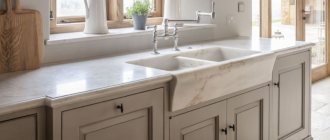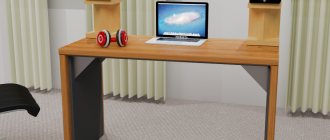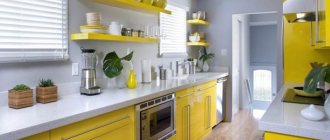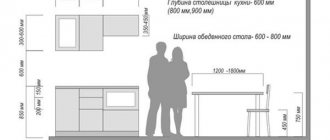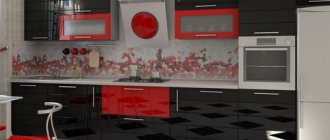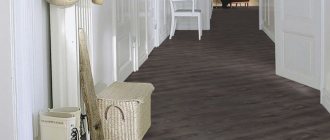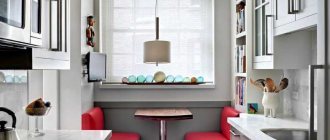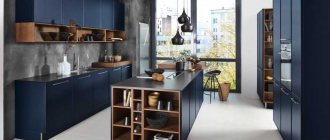In the store's offer you will find complete sets of kitchen furniture, which can certainly please even the most demanding customers. However, if you want to create something unique and customize the furniture to suit your individual needs, then bespoke kitchens are a good choice. Moreover, recently this service has become widespread, so it is not at all difficult to find qualified craftsmen.
A custom-made kitchen is a great opportunity to create furniture that suits our needs and habits. You can order a unique design and execution of any number of cabinets, and also choose their size to suit your individual needs, your height, the characteristics of the room in which they will be installed and other parameters. Kitchen planning is planning the size of the countertop, upper and lower cabinets, height, on which you want to hang or install them. What fronts and doors will you choose for furniture, what filling? These and many other questions will be asked by those who plan to make a kitchen themselves or order it from a craftsman. All these meanings are very important and significant.
Height of kitchen countertop from floor
A standard kitchen countertop is installed at a height of 82 cm. The countertop itself, depending on the material, can have a thickness of 2 to 4 cm (there are, of course, thicker countertops). Thus, the height of the surface of the kitchen countertop from the floor is at a height of 86 cm. As a rule, the level of the working surface of the countertop is not made lower, but sometimes it is raised to 90 cm, or a maximum of 95 cm for very tall people. Higher countertops are considered bar countertops, and it is difficult to work on them in a standing position due to the unnatural position of the arms.
Height of kitchen cabinets from floor
Lower kitchen cabinets are the backbone of even the most minimalist kitchen. If recently it has been fashionable to abandon wall cabinets or design them in a minimal form and quantity, then we cannot do without lower cabinets. They are used to store culinary utensils, a dishwasher, sink, oven, stove are built into them, and they serve as the basis for a work surface - a countertop. Their dimensions have a decisive influence on comfort and must be tailored to the individual needs of the users.
The height of the lower cabinets must be adapted to the tabletop. If you want to get a worktop at a height of 86 cm from the floor, then the standard height of kitchen cabinets should be 72 cm. The length of the legs will be added to it - 10 cm and 4 cm of the table top, for a total of 86 cm.
If you decide to install the tabletop at a higher level, you can adjust the height of the legs or order cabinets with a height of more than 72 cm. The legs are available in different sizes, the standard is 10, 15 and 20 cm. The base can also accommodate additional drawers for kitchen cabinetry.
However, when adjusting the legs, we must remember that this method significantly affects the appearance of the furniture. Skirting boards higher than 10 cm will visually add massiveness to the furniture.
Standard sizes of kitchen units
As already noted, kitchen furniture modules can be placed on the upper and lower levels. Their typical sizes were determined taking into account the average physiological characteristics of a person, mainly his height.
Kitchen unit dimensions
GOST regulates standards for certain dimensions of interior items installed in the kitchen.
Table. Standards set for kitchen cabinets.
| Parameter | Size, mm |
| Module height (including table top) | 850…900 |
| Tabletop depth | 600 |
| Depth of the lower cabinet (internal), not less | 460 |
| Depth of wall module (internal), not less | 270 |
| Height from floor to top shelf of wall cabinet, no more | 1900 |
Kitchen furniture dimensions
In practice, the parameters of furniture offered to the consumer often differ slightly from the specified values.
Dimensions of lower modules
Furniture modules
When purchasing standard furniture, you need to pay attention to the following characteristics:
- optimal overall height of floor cabinets: 85...95 cm. In this case, the thickness of the tabletop is also taken into account, varying from 2 to 5 cm (it depends on the model and material from which the tabletop is made);
- the depth of the desktop surface is usually 60 cm;
- the tabletop can protrude 5 cm from the facade. The table surface can protrude to the same distance in relation to the back wall;
- cabinets can have a base at the bottom measuring 8...10 cm;
- standard module depth: 50 or 55 cm;
- The width of the lower cabinets is usually selected from the range: 30, 40, 45, 50, 60, 80 and 90 cm.
Important! Recently, multi-level work surfaces have become popular among designers. This is due to the fact that it is more convenient for housewives to perform various operations when preparing food at different levels. For example, it is comfortable to process food at a height of 90 cm, to wash dishes at a level of 100 cm, and to cook on a stove with a hob installed at a distance of 80 cm from the floor.
Dimensions of suspended structures
The standard dimensions of the upper modules are also designed for the average housewife.
- Height: 60, 70, 80.90 cm (some manufacturers may also offer a cabinet with a height of 120 cm).
- The depth of the structures is usually 30 cm.
- Width standards correspond to the parameters of the lower cabinets.
Upper kitchen modules
The distance between the shelves in the cabinet can be 20 or 30 cm. Despite the fact that current standards determine the maximum height of the top element to be 190 cm, however, it is also possible to exceed this parameter. In addition, wanting to make maximum functional use of the entire space of a small kitchen and installing structures almost to the ceiling, many deliberately resign themselves to possible difficulties.
Despite the accepted standards for hanging cabinets, which take into account the ease of their operation, if the apartment owner wishes, higher structures can be installed. Frequent use of the upper shelves is not very convenient, especially for those who cannot boast of significant height.
Cabinet sizes and ease of use
However, to accommodate products and items that are not used very often, in kitchens with high ceilings it is not uncommon to fill all possible space with furniture. To make it easier to get what you need, many people use small stepladders or stools.
Today, interesting solutions are offered for organizing access to areas of wall cabinets suspended high. For example, the installed electric drive allows you, after pressing a button (in some models, you can simply pull the handle), to lower the top shelf down to the required distance.
Lift system for kitchen cabinets
A stepladder that extends (after pressing the keys with your foot) from the lower cabinet also helps to operate all the compartments of the wall cabinet as needed. In this case, there is a big disadvantage of the design - the device hidden in the module takes up space that could be used for storing kitchen utensils or installing equipment. Designs that fold into drawers have also been developed.
Extendable stepladder
The design of a kitchen set may involve various ways of installing wall-mounted structures:
- at the same height;
- at different distances from the ceiling and work surface.
Of course, if there is such an opportunity, it is more convenient to order furniture with individual parameters. In this case, you can easily take into account the wishes of the hostess and use the available space as functionally as possible.
Installation height of upper level cabinets
To make it convenient to work in the kitchen and to place household appliances on the countertop, you should not hang the cabinet below 45 cm from the work surface. If the owner's height exceeds average, this parameter can be increased to 60 cm.
Installation height of upper level cabinets
There is a dependence of the installation height of the modules (lower part) on the height of the main cook.
Table. Distance from the bottom surface of hanging cabinets to the floor.
| Man's height | Distance, cm |
| 175…178 | 150 |
| 185 | 160 |
| 200 | 175 |
When installing cabinets in which exhaust devices are built-in, the standards for the placement of this equipment become decisive. In kitchens with gas stoves, hoods cannot be installed lower than 75 cm above the hob. If we are talking about electric stoves, then it is recommended to maintain at least 65 cm.
The upper modules can be mounted on a wall where there are no floor cabinets or work surface. In this case, they are guided by the ergonomics and design of the entire headset. The same principle is used when installing furniture above appliances (refrigerators, ovens, microwave ovens, etc.).
Wall cabinets in the kitchen
When calculating the distance from the tabletop to the bottom of the hanging furniture, first of all you need to focus not on the rules, but on your preferences. Despite accepted standards, some install cabinets at a height exceeding 70 cm. This is more convenient for them.
Incorrectly placed upper modules can significantly complicate the cooking process for the housewife. This not only leads to rapid fatigue, but is also fraught with injury. There are often cases when a cook hits a cabinet with his head. One of the reasons for the problem is the low location of the piece of furniture.
Important! Before ordering furniture, you need to prepare a drawing in order to correctly calculate all the parameters.
Depth of lower kitchen cabinets
The width of individual elements of a kitchen set may vary.
Standard base cabinets are 51cm deep with a 60cm worktop. Behind the furniture there is 5cm of free space for electrical equipment and other necessary communications. Then comes the 51cm deep body and fronts. Depending on the material, the fronts can have different thicknesses, on average about 2 cm.
Of course, these are indicators for simple standard built-in furniture that does not require non-standard solutions. Cabinet furniture with a depth of lower cabinets of 51 cm can easily accommodate equipment, drawers with a length of 50 cm, kitchen cargo or drawers.
The depth of the lower cabinets can be arbitrarily increased or decreased, and the dimensions of the tabletop must also be changed along with it.
Taking measurements
First, decide how much area of your space there is for the kitchen, and how you plan to place the kitchen unit.
Next, measurements are taken. Here you need to pay attention to the following points:
- First measure the height from the floor to the ceiling. Please note that in many homes, indicators may differ at different points in the room. Because of this, mounting cabinets directly to the ceiling is potentially dangerous. After all, the height may not coincide in different angles;
- Then you need measurements from wall to wall. This refers to opposite surfaces;
- Don't forget to take measurements of door and window openings;
- Indicate on the diagram the free space required for the free opening of doors and windows.
Currently, you can find 2 types of kitchen sets. These are standard and non-standard.
Depth of wall kitchen cabinets
The standard depth of wall cabinets is 30 cm - body and 2 cm fronts, which gives us 32 cm. In this case, the useful depth is 28 cm. This is enough to accommodate even large plates, glasses, cups and food items. This figure may increase or decrease.
Keep in mind that by reducing the depth, we deprive ourselves of the possibility of installing a built-in hood, dish dryer or elevator system. Increasing this indicator will add heaviness to the set, and hanging cabinets may enter the work area. So, if the height of wall kitchen cabinets is standard and the depth is increased, then it is very likely that you will hit your head on the furniture while working.
Working triangle rule
In the kitchen, all cabinets and household appliances should be located so that little effort and time is spent when preparing food. Therefore, in this room you should definitely apply the rule of the working triangle - place functional zones on its tops within 1-2 m from each other.
The main zone accents in the kitchen are:
- refrigerator, food cabinets;
- sink, table;
- hob, oven.
Triangular arrangement of furniture in the kitchen is possible according to the following schemes:
- In one line. The cooking area is located between the refrigerator and appliances.
- In two rows. On one side of the kitchen there is a working and storage area, on the other there is a dining area.
- Island. In the allocated space there is either a stove/oven or a sink; all other furniture occupies the space along the walls.
- Peninsula. There is a separate table or bar counter with equipment for processing or preparing food.
- L-shaped layout. The refrigerator is installed in one corner, and the hob and oven with sink are in the other.
The working triangle rule was developed according to the method of Feng Shui, the Chinese teaching about the influence of the location of various objects on a person.
